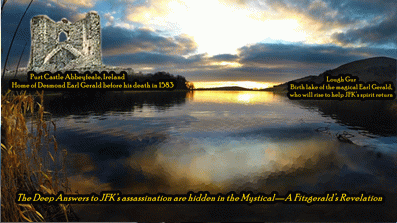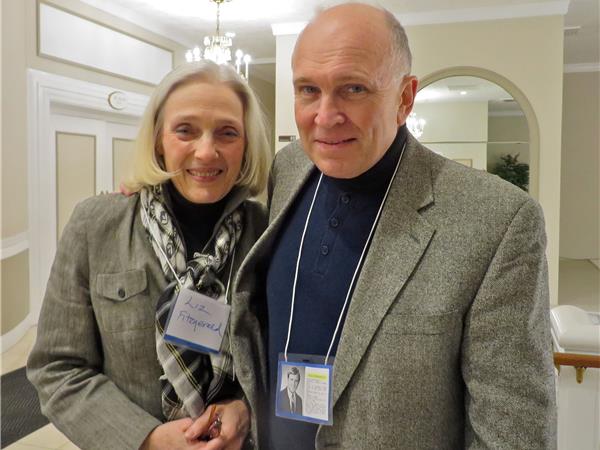
Purt Castle Abbeyleale, Ireland Home of Desmond Earl Gerald before his death in 1583 and Lough Gur, Birthlake of the Magical Earl Gerald who will rise to help JFK's spirit return
(Image by Paul Fitzgerald) Details DMCA
I was twelve years old the day JFK was killed and I remember it as if it were yesterday. I was grief stricken but old enough to understand that if someone was willing to execute the president of the United States in broad daylight under the full protection of the United States Government and get away with it, what chance did any of us have when the murderers finally decided to turn their guns on us.
Over the years I came to see that there were any number of people willing and capable of doing what happened on November 22, 1963. My own bookshelf contains a dozen deeply researched books about the subject (many by our own publisher Trine Day). Seen from that moment in time their logic all work perfectly. But for me there was always something missing.
So today I want to present a connection to an older and deeper background story about JFK that puts his assassination into a broader historical context that we hope you'll find worthy of serious consideration. When Liz and I met in 1970 I had no reason to think we'd spend forty years digging into a thousand-year-old family history. Nor did I imagine we'd be shocked into believing there was a mystical aspect to the JFK assassination.
The first hint that I was being drawn directly into the JFK Saga came in early 1980 when we were invited to hear Ted Kennedy's challenge to President Carter's nomination for a second term. As soon as we arrived at the event, one of the organizers came over to introduce a Kennedy insider named Al Lowenstein. Lowenstein had been the driving force behind Robert Kennedy's campaign in 1968. He'd carried on after RFK's death and spent most of the 1970s researching both murders. Just being a Fitzgerald was enough for Lowenstein to make me a confidante and he made his intentions clear when he told us in a hushed tone, "We've got to get Ted elected and finally bring those CIA sons of bitches that killed Jack and Bobby to justice. Since you're family I can tell you this. We know who did it and people are willing to talk. But we need the presidency to protect them."
I thought that was the end of it, until two weeks later when we read that Al Lowenstein had been murdered by a colleague who walked into his office, shot him seven times, then put the gun down and waited for the police. Lowenstein's murder made me wonder whether he hadn't known something was brewing and was passing on the mission before it got too late. And so began our journey that winds its way from Boston to Kabul, to Jerusalem to Paris and the Holy Grail and Scottish Rite Freemasonry and from there to the death of JFK. By the end of this presentation you should know why JFK was destined to meet his fate on November 22, what the Fitzgerald legacy reveals about how that came to be - and how we believe it will lead to the resurrection of JFK's Vision of World Peace at the closing of our era.
Everybody knows JFK was shaking up the deep state but it turns out there was a tradition behind his behavior. Thanks to his maternal grandfather John Francis Fitzgerald he had been made aware of his family's roots going back to the foundation of the British Empire and was most likely informed that old grudges die hard. JFK's declaration that he "wanted to splinter the C.I.A. into a thousand pieces and scatter it to the winds" has been on everyone's shortlist of motives from the beginning. But few may realize what that phrase would have meant to the people he was threatening to splinter - considering they saw themselves as modern-day Knights Templar tasked with guarding the Holy Grail. It might be hard to believe that America's elite Cold Warrior spies of the1940s, '50s and '60s considered themselves to be Holy Warriors. But if you look at it through the filter of a black and white Manichean struggle for power that had seesawed back and forth between Rome and London through the centuries you might get a better idea of how they viewed their mission.
Let me start by addressing some assumptions that I came to know simply by growing up as a Fitzgerald in a small suburb north of Boston. Back at that moment in time I was known to my friends as Fitzy and that I was unquestionably Irish. As I grew older I came to know that the Fitz in Fitzgerald was Norman French for the son of a 12th-century Anglo Norman baron named Gerald of Windsor born in the year 1075 or according to my Y-DNA records - Walter Fitz Otho his father whose birth dates to 1025. I also came to know that the name Gerald derived from the Old German Gervald meaning Spear Ruler, which it turns out - is apparently what the family did best. The Fitzgeralds were what is known as Familiaris Regis - members of THE ROYAL INNER COUNCIL - and were the product of Gerald's marriage to a princess of Wales named Nest - daughter of the last Welsh King of Deheubarth, Rys ap Tewdwr. I also found out that being a Fitzgerald from a little village called Abbeyfeale in the Southwest corner of Ireland came with a lengthy and complicated history.
My grandfather Michael Fitzgerald was the oldest son of the oldest son of the oldest son and inherited a 500-acre farm in Abbeyfeale that he'd left in the hands of his brother Ned before heading for Massachusetts in 1900. By 1912 Michael had worked his way up to being a union official for the Eastern Mass Street Railway Company and got to sit down with JFK's grandfather - Boston Mayor John Francis Fitzgerald - to iron out the difficulties surrounding a serious rail strike. After what I assume was a profound session of solemn prayer at the Parker House bar across the street from city hall, they proceeded to share backgrounds on their respective Fitzgerald lineages and determined that they were closely related.
It seems there were two main branches of the Fitzgerald family in Ireland, the Earls of Kildare and the Earls of Desmond, both descending from Gerald of Windsor, and that our branch connected back through the Earls of Desmond.
The record of the Fitzgerald's arrival in Ireland under the English King Henry II in 1169 is well documented and was recorded in a book known as the Expugnatio Hibernica written by another family member named Gerald de Barri. De Barri was a famous 12th-century prelate and grandson of Gerald of Windsor and Princess Nest whose Tudor lineage made the family contenders to the throne of England. And as a rival Norman family with a Welsh lineage directly connected to the source of Arthurian legends and the Holy Grail - it also made their intentions highly suspect.
Gerald of Windsor had already been sent to Ireland by Nest's family in 1102 on a diplomatic mission to unite Wales and Ireland against the new English King Henry I. The 12th century was a time of constant power struggles. At the time of the Norman invasion of Ireland, the sovereignty of Scotland, Ireland and Wales was up for grabs. An enterprising Norman baron with an extended family of mercenary knights at his disposal could establish a rival kingdom at will and attain sovereignty over it with the Pope's blessing. Such was the case with the Fitzgeralds and their association with the Earl of Pembroke, Richard de Clare, known as Strongbow. Strongbow was a Welsh Marcher Lord whose ancestry (like William the Conqueror) went straight back to the Viking Rollo with close family ties to the Fitzgeralds and strong financial support from London's Bankers. Gerald de Barry described the earl as "of high descent, for he was born of the noble stock of Clare. Yet withal, so far, a man whose family was better than his fortune; who had more blue blood than brains, and whose pedigree was longer than his purse."
Strongbow would pass on his lineage down through the ages and in January 2005 a study revealed that among Strongbow's descendants was one George W. Bush, President of the United States. Strongbow's grandfather and great uncle rode with the hunting party that day in 1100 when King William Rufus was assassinated in the New Forest and a daughter known as Adeliza was married to the assassin, Walter Tyrel. The De Clares had gained power and influence under Rufus's successor Henry I, crusaded in the Holy Land, went to war against Henry II's mother Matilda during the "anarchy" that followed Henry I's death and operated a serious military-industrial complex on the border of England and Wales second only in size to the City of London. Strongbow had accepted the invitation of Ireland's King of Leinster, Dermot Mac Murrough, in 1167 to help him reclaim his Kingdom and in payment receive his daughter in marriage as well as the Kingship of Leinster upon Dermot's death.
Next Page 1 | 2 | 3 | 4 | 5 | 6 | 7 | 8
(Note: You can view every article as one long page if you sign up as an Advocate Member, or higher).





